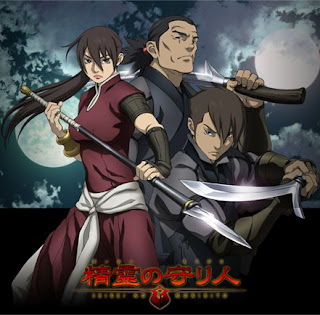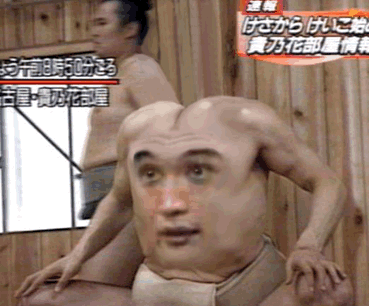Seirei no Moribito
(Guardian of the Sacred Spirit)
Seirei no Moribito (or Guardian of the Sacred Spirit), is not your normal anime. It began life as the first in the ten volume Moribito series of fantasy novel written by Uehashi Nahoko (who is also the author of
Kemono no Souja Erin), and although these novels were mainly intended for children they also gained many adult fans. In fact the novels proved to be so popular, the first volume was adapted into a manga, an anime (directed by Kamiyama Kenji, who also directed Ghost in the Shell SAC and 2nd Gig), and even a radio drama. The novel was also scheduled for release in english in mid 2008 because of the immense popularity of the anime adaptation.
One of the most surprising aspects of this series is the approach taken with the visuals. Kamiyama and his team seem to have adopted an unusual approach in this department, the results of which are some of the smoothest and most fluid animated sequences of any show produced over the last few years. Production I.G. have managed to create one of the best looking anime of 2007, and with it managed to introduce one of the most unique and interesting female leads in anime. That said, the colour palette is very “Ghibli-esque” as it mainly uses greens, browns, blues, etc, but these have been put to good use with the characters and environements, and the overall effect is more reminiscent of “Monoke Hime” or “Gedo Senki” than anything else.

The character designs are exceptional throughout the show, most especially the main and immediate supporting characters. Balsa is exceptionally well designed, and far more realistic than many other fantasy female leads. Her character is fairly muscular and stocky, yet without the extremely toned muscles shown in most other fantasies. Facially too, the designers went for realism more than anything else. Balsa is not beautiful, but not ugly either. She’s plain (in a sense), and is most definitely a woman, not a girl.
The other characters are also designed very much with realism in mind, and this actually helps to pull the viewer into the show in a big way. It’s also nice to see that attention was paid to the animals in the show as well, and it makes a nice change to see a horse in anime that actually looks like a horse.
One thing that should be mentioned here is the design influences. Many people relate thise series to China and Japan because of the very obvious visual references to those countries (i.e. the palace, the emperor, the ninjas, etc), however this is really only a small part of the whole. In truth, Seirei no Moribito isn’t simply based on China and Japan, but is actually based on the greater Indo-Chinese region. This is reflected in the differing facial structures, customs, practices, etc, that are seen in the show. Balsa and Jiguro are originally from Kanbal, a country that shows a number of elements of Northern India/ Kashmir, Nepal and Tibet. This influence also extends to Balsa and Jiguro’s fighting style, which is very different to that of the stories other combatants. The backgounds, still scenes, the rural settings, even the mountainous regions and jungles, are very clearly based on the region of South-East Asia stretching from India to Japan, and it’s a rarity to find this kind of scope or depth of detail in anime.

The animation quality throughout the show never really lets up, and the action sequences are especially impressive. The fights are swift and well executed, and the movements of the combatants are especially impressive during the action scenes. Production I.G. have also paid attention to the different combat styles used in the show as well, and have managed to include these in the animation, which gives the fights a far more “authentic” feel.
Each episode opens with a very nice, and rather catchy, J-rock/pop ballad called “Shine”, which was performed by L’Arc-en-Ciel but never released as a single. The rest of the music in the show (composed by the famous Kawai Kenji), adds to the atmosphere and overall feel of the show. The dramatic moments, fights, and even the slow-paced scenes are all emphasized with some great background pieces.
The sound effects are exceptional in this show, especially as this is more of a “historical” fantasy. The background noises, the grunts, clucks, whinnies, and other noises of the various animals, the clash of steel on steel, and a whole host of other noises breathe life into the series, and make the settings that much more “real”.
It goes without saying that the star of the show is Balsa, the spear wielding warrior woman, and she, as a character, is one of the strongest and most unique female leads in any anime to date. She is muscular and stocky, possess many skills (not the least of which is her formidable fighting ability), has a strong sense of right and wrong, is very rarely indecisive, and is sensible in many ways. As I’ve said earlier, Balsa is no beauty, and this again sets her apart from many other female leads, as the designers generally try to make lead women in anime “attractive” to male audiences.
Chagum, on the other hand, is exactly how you would expect a young prince to be, but without the arrogance (which makes a nice change). What makes this series really work though, is the attention to character development that both Balsa and Chagum receive, and how, as each of them develops, their relationship with each other changes.

There are several other characters who appear throughout the series (Tanda, Touya, Saya, Jiguro, etc), all of whom receive a certain amount of development because of their association with Balsa. The nice thing about the development of the supporting characters is that it is often directly linked to the development of either Balsa or Chagum, or both in some cases. This is most especially true in the case of Jiguro, who was Balsa’s guardian and mentor as a child, and is the one who taught her how to fight with a spear. The various references and flashbacks to this character slowly begin to make sense as the series progresses, and with this clarity it is possible to understand Balsa’s character even more.
There is a downside to the characters though, in that there are those who receive little to no development. In addition to this, the characters who do receive development rarely get it continuously. Strangely enough though, this does very little to impact on the story or the viewers enjoyment of the show.
The story is actually a nice role reversal of the typical “rescue the princess” scenario and, although it’s meant to be a serious fantasy action drama, there are some genuinely humourous moments.
The plot flows at a nice steady pace throughout the series, and although it does slow down from time to time, these are often the times when the majority of the character development occurs. The premise is very good on the whole, and although the story can, at times, seem more like stock fantasy, there are enough differences, as well as some great character development, sound and animation, to make watching this a worthwhile experience.
This isn’t a light-hearted series, but it also doesn’t become overly dramatic. It doesn’t focus so much on action that it gives up areas of the story, and it never lets the story become so bland that you get bored of watching. It’s an interesting show with some unusual fantasy elements, and the slow delve into Balsa’s past is enough to keep many viewers watching.
Although the plot may be simplistic at times, this isn’t really a show that suffers from it, especially as the story itself is more character driven than anything else. The main focus of the Seirei no Moribito is the characters, and this is emphasized by the fact that the action and drama clearly take second place.
Overall I’d recommend Seirei no Moribito to any Ghibli fan, and also to anyone who like shows like Claymore, Slayers, Rurouni Kenshin or Sword of the Stranger. It’s an extremely enjoyable example of how good a fantasy series can get if you do it right, and because of it’s characters, it will appeal to fans of many different genres.
And with any luck I’ll be able to find the novels in English soon too.





































